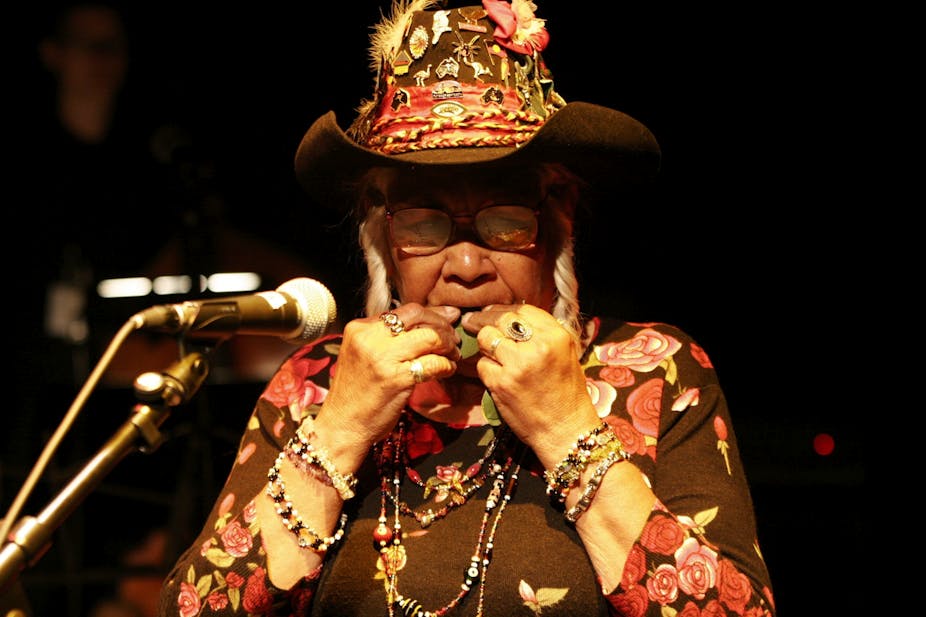She was born under a lantana bush on Stuart Island, an Aboriginal reserve in the Nambucca Valley of New South Wales. As a child, her extended family gathered around the campfire for evenings of music-making and storytelling. There, the sounds of her leaf-playing uncles so fascinated her that by the age of eight she had acquired a proficient gumleaf technique.
Today, gumleaf virtuoso Roseina Boston celebrates her 80th birthday.
Practice, practice, practice
The gumleaf is a wind instrument (or aerophone) that comes with a steep learning curve. Beginners struggle to make any sound at all, and due to the essential oils characteristic of eucalypts, leafists experience a strong taste of resin after blowing just a few notes.
Held against the lips with the fingers, the gumleaf acts as a vibrating valve when blown. But sounding a gumleaf involves more than blowing, and Boston avoids the word:
It’s sealed off all between the lips. You’re not blowin’ it – you just give a little toot.
Meanwhile, Aboriginal gumleaf virtuoso Uncle Herb Patten encourages beginners to explore not just blowing, but also humming and whistling over the leaf.
Leaf technique varies: either flat or folded, placed firmly against the lower lip and lightly against the upper lip—or the reverse, stretched between one or both hands (some virtuosos have even crafted a “no-hands” technique, allowing them to simultaneously play another instrument).
Leaf after leaf
Gumleaf musicians draw on a variety of species. While some opt for the leaves of native eucalypts (commonly referred to as gum trees) such as yellow box, turpentine, and river red gum, others have taken up introduced species such as lemon and rose. While she prefers the ghost gum, Boston will play “any leaf at all — even lemon”, she told me.
Much more than a toy or novelty, the gumleaf is a highly expressive and evocative instrument. Notes can be muted (by cupping the hands), bent, or trilled. A glide from one note to another is possible, as are pulsating, warbling, and “wah-wah” effects.
Boston produces a rich, warm sound reminiscent of the distinctive soprano saxophone of Sidney Bechet , with a really wide vibrato. Comparisons can be also struck with the clarinet, kazoo, flute, violin, and trumpet.
Where “leafing” began
Leaf-derived instruments have featured in the music of Oceania, southern China, Ecuador, central Europe, and Mexico. Nevertheless, the gumleaf serves as a quintessentially Australian environmental, aromatic, and sonic icon, although little is known of its presumed long history.
Boston believes that in pre-contact days, Aboriginal hunters applied their leaf skills to mimicking birds as a sort of hunter’s decoy. Some speculate that leaves were used for signaling, for instance calling children home.
On his expedition to far-west Queensland in 1876, explorer and journalist William Hodgkinson shot an emu, which he gifted to a native camp. Of the Aboriginal singing and dancing that ensued, Hodgkinson praised a sweet-sounding instrument that he compared to a jew’s-harp. Gumleaf scholar Robin Ryan counts this as the earliest documentation of Aboriginal leaf playing.

As bands formed, singing, drums (made of possum or kangaroo skins), and other instruments such as clapsticks, bones, spoons, guitar, ukelele, and accordion often accompanied leaf musicians.
The South Australian Salvation Army recruited an Aboriginal “Eucalyptus Band” in 1892 for a street march. The brother of Boston’s grandfather, Uncle George Possum Davis, was well known for his Burnt Bridge Gumleaf Band in the 1920s and 30s.
The Leaf Band’s vaudevillian performances took in jazz, corroboree steps, hula dancing, and clowning.
Through the decades, repertoire came and went: hymns, patriotic songs, jazz, country and western, and even John Lennon’s Imagine all had their gumleaf moment.
From 1977 to 1997, the (now-defunct) Australian Gumleaf Playing Championship drew Aboriginal and non-Aboriginal contestants alike to Maryborough, Victoria.
Roseina Boston: onstage and off
Onstage, Boston dresses flamboyantly – as an Aboriginal country and western artist – and peppers her performance with stories. Her varied repertoire includes originals, hymn tunes, and popular and patriotic songs.
All of her original music is revealed to her in dreams, as are her paintings and her personal totem – the cacophonous laughing kookaburra. Boston is skilled in mimicking it and other birds, including the noisy friarbird, willie wagtail, whipbird, and square-tailed kite.
She also plays to birds:
It’s so magical in a way, when I walk through the bush playin’ my gumleaf, just pickin’ a leaf and playin’. All the birds come around me. I love it.
Mother to eight, grandmother to 35, and great-grandmother to 20 – she claims her family has shown scant interest in learning the gumleaf. And despite her frequent visits to primary schools to tell stories and play gumleaf, Boston considers leafing a dying art.
Gone are the days when Aboriginal leafists performed at events like the opening of the Sydney Harbour Bridge (March 20, 1932).
“What has happened to this tradition?” asks musician Jon Rose in his book The Music of Place. “Why isn’t there a 20-piece gumleaf band marching down George Street on Australia Day? This is the New Orleans jazz of Australia – who is looking after this, who is nurturing this?”
This article was prepared with assistance from Dr Robin Ryan of Edith Cowan University.

